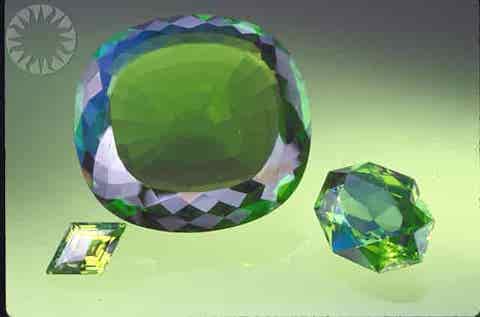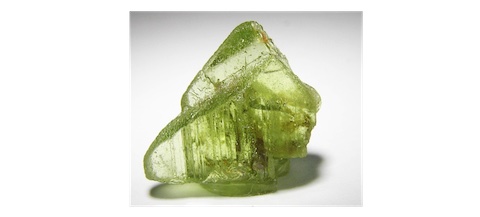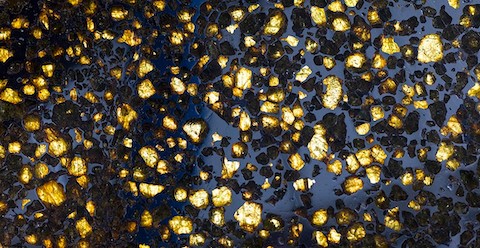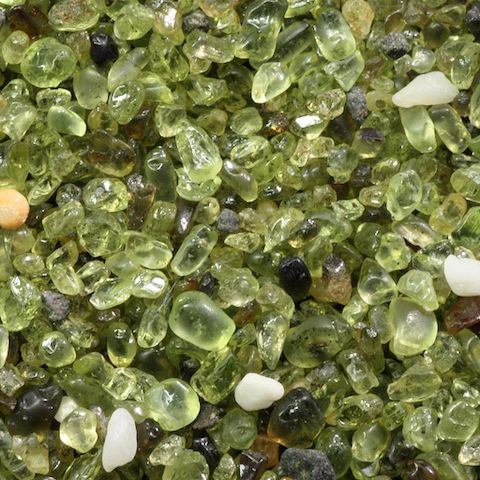
Credit: Dane A. Penland (Smithsonian Institution)
If your birthday is in August, your birthstone is peridot. And if you have one, you can be sure it came from deep within the Earth—or deep in outer space!
Peridot is the gem name for a gem-quality example of olivine.
Olivine is very common inside the Earth, where it makes up an astonishing 50 percent of Earth’s upper mantle. But it’s much less common on the surface.
It’s found where tectonic forces push mantle up and over Earth’s crust, or where volcanic activity brings up mantle in the form of lava, which can contain peridot crystals.
The most celebrated source of peridot was the tiny Egyptian island of Zabargad, which was pushed up in the region that is now the Red Sea when the African and Asian plates collided 600 million years ago.
Zabargad has been mined since the third century BC and has produced some of the world’s best peridot gemstones. Today, the largest mines are in Myanmar and Pakistan.
A much rarer source of olivine is meteorites that break off from a planet or asteroid large enough to have a mantle then enter Earth’s atmosphere.
These spectacular meteorites contain olivine crystals held in a dark nickel-iron metal matrix. Of the thousands of meteorites found, only 45 contain olivine.
So, if you have a peridot, you can marvel at the long distance it traveled to get to you from deep inside—or far outside—the Earth.
Background
Synopsis: If you have an August birthday, your birthstone has two unique origins. Beautiful olive-green peridot is formed either in Earth’s mantle or among the stars. Ancient Egyptians called them evening emeralds, and geologists call them olivine. They may also help sequester carbon dioxide.
- Peridot is gem-quality olivine, a transparent mineral with an oily luster ranging from golden to grass green in color. Olivine was named because of its olive-green color.
- Olivine makes up at least 50% of Earth’s upper mantle. Other upper-mantle minerals include aluminosilicates of the pyroxene group, calcium oxides and aluminum oxides.
- On Earth’s surface, olivine can be found in ultramafic igneous rocks like basalt, gabbro and peridotite.
- Olivine can be found in places where tectonic forces have pushed slabs of upper mantle to the surface and in places where volcanic rocks bring mantle material to Earth’s surface in dark, iron- and magnesium-rich lavas.
- Olivine’s high crystallization temperature makes it one of the first minerals to crystallize from magma, so specimens may be found within volcanic basaltic lava.
- When metamorphosed, olivine converts to serpentinite with other ultramafic minerals.
- Olivine ((Mg, Fe)2SiO4) is a solid solution series. It is a silicate that ranges between two end-member minerals, forsterite (Mg2SiO4) and fayalite (Fe2SiO4), with magnesium (Mg) and iron (Fe) easily swapping out with each other in the olivine crystal structure.
- Most mantle peridot is the magnesium-rich end member forsterite, which ranges in color from transparent when pure to green and gold as the amount of iron substitution increases.
- Iron-rich fayalite tends to be gold in color and is more prevalent in meteorite gems.

Credit: Rob Lavinsky, iRocks.com – CC-BY-SA-3.0, CC BY-SA 3.0, via Wikimedia Commons
- Earth’s first source of mantle peridot gemstones was Egypt’s Zabargad Island, a tiny desert island in the western Red Sea off the east coast of Egypt.
- The rocks on the island were crushed upward when the African and Asian plates collided, bringing mantle rocks toward Earth’s surface 600 million years ago.
- Then, the island was further altered and uplifted during the rifting episode that opened the northern part of the Red Sea starting about 20 million years ago in the Miocene Epoch.
- Late-stage hydrothermal veins host gem-quality olivine crystals up to 8 in (20 cm) long in a soft serpentinite matrix, making them easy to remove.
- Zabargad Island has three exposed peridotite masses and has been mined since at least the middle of the third century BCE on the basis of amphorae (large vases) discovered in the mines.
- Egyptians believed the stones were magical and could ward off evil and stop nightmares.
- In 79 CE, Pliny the Elder wrote about gems from the island in Naturalis Historia.
- Earth’s largest cut peridot is nearly 312 carats and came from the mines of Zabargad.
- Today, peridot gems range in price from $50 to $80 per carat for smaller, well-cut, 1–2-carat gems up to more than $400 per carat for larger gems of top color.
- The Egyptian mines of Zabargad have not been active for decades, but today large gems are mined in Myanmar and Pakistan.
- Other sources include Australia, Brazil, China, Kenya, Mexico, Norway, Saudi Arabia, South Africa, Sri Lanka, and Tanzania.
- In Arizona, smaller gems (up to 10 carats) are hand hammered out of basalts at the San Carlos Apache Indian Reservation, east of Phoenix.

Credit: Natural History Museum, London
- Peridot also arrives on Earth within stony-iron pallasite meteorites derived from asteroids or planets that were large enough to form a differentiated mantle layer or from extraterrestrial impacts.
- Arguably the most beautiful meteorites, pallasites usually consist of gold and brown iron-rich fayalite crystals in a nickel-iron metallic matrix called kamacite.
- Although there are thousands of identified meteorites, only 45 of them are pallasites.
- They are named after Peter Pallas, who was the first to identify the origin of a 1500-lb (680-kg) meteorite found in the mountains of Siberia in the 1770’s, before scientists believed extraterrestrial objects could fall to Earth.
- Pallasite falls have only been witnessed four times on Earth: in 1826 in Sicily, Italy; in 1898 near Kami City, Kochi Prefecture, Japan; in 1902 in Karelia, Russia; and in 1981 in Omolon, Russia.
- Large finds have occurred globally: in 1890 more than 20 masses amounting to several tons of meteorites were found in Brenham, Kansas; in 1937 a mass weighing 3,100 lb (1,400 kg) was found in Australia’s Northern Territory; a 2,211-lb (1,003-kg) meteorite was found in Xinjiang Province, China, in 2000; numerous masses weighing about a ton were found near Imilac in Chile’s Atacama Desert in 1822; and in 1951 a 1,665-lb (755-kg) mass was found in Esquel, Argentina.

Credit: Siim Sepp, CC BY-SA 3.0, via Wikimedia Commons
- Olivine is at home under mantle conditions, so it is easily weathered on Earth’s surface.
- Sedimentary deposits of olivine can only occur near their ultramafic sources.
- Fresh surfaces readily react with carbon dioxide, weathering into magnesium carbonates and quartz, so milled olivine has been considered an important resource to be evaluated for carbon sequestration. However, left exposed, olivine surfaces generate a carbonate crust that limits further reaction, so sequestration applications require constant reworking to maintain unreacted surfaces. Research is ongoing in this field.
- If your birthstone is peridot, you have an amazing story to tell.

